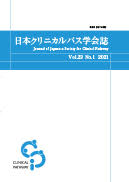Volume 22, Issue 2
Journal of Japanese Society for Clinical Pathway Vol. 22 No. 2 2020
Displaying 1-12 of 12 articles from this issue
- |<
- <
- 1
- >
- >|
Study Report
-
Article type: Study Report
2020Volume 22Issue 2 Pages 77-84
Published: July 15, 2020
Released on J-STAGE: March 30, 2023
Download PDF (1979K) -
Subject area: Study Report
2020Volume 22Issue 2 Pages 85-92
Published: July 15, 2020
Released on J-STAGE: March 30, 2023
Download PDF (1079K)
Special Topics (The 20th Annual Congress)
-
Article type: Special Topics (The 20th Annual Congress)
2020Volume 22Issue 2 Pages 93-97
Published: July 15, 2020
Released on J-STAGE: March 30, 2023
Download PDF (1019K) -
Article type: Special Topics (The 20th Annual Congress)
2020Volume 22Issue 2 Pages 98-102
Published: July 15, 2020
Released on J-STAGE: March 30, 2023
Download PDF (1002K) -
Article type: Special Topics (The 20th Annual Congress)
2020Volume 22Issue 2 Pages 103-106
Published: July 15, 2020
Released on J-STAGE: March 30, 2023
Download PDF (1073K)
Special Topics (The 20th Annual Congress)
-
Article type: Special Topics (The 20th Annual Congress)
2020Volume 22Issue 2 Pages 107-110
Published: July 15, 2020
Released on J-STAGE: March 30, 2023
Download PDF (1029K)
Special Topics (The 20th Annual Congress)
-
Article type: Special Topics (The 20th Annual Congress)
2020Volume 22Issue 2 Pages 111-114
Published: July 15, 2020
Released on J-STAGE: March 30, 2023
Download PDF (701K) -
Article type: Special Topics (The 20th Annual Congress)
2020Volume 22Issue 2 Pages 115-119
Published: July 15, 2020
Released on J-STAGE: March 30, 2023
Download PDF (1416K) -
Article type: Special Topics (The 20th Annual Congress)
2020Volume 22Issue 2 Pages 120-125
Published: July 15, 2020
Released on J-STAGE: March 30, 2023
Download PDF (1370K)
Special Topics (The 20th Annual Congress)
-
Article type: Special Topics (The 20th Annual Congress)
2020Volume 22Issue 2 Pages 126-129
Published: July 15, 2020
Released on J-STAGE: March 30, 2023
Download PDF (1229K) -
Article type: Special Topics (The 20th Annual Congress)
2020Volume 22Issue 2 Pages 130-134
Published: July 15, 2020
Released on J-STAGE: March 30, 2023
Download PDF (1385K) -
Article type: Special Topics (The 20th Annual Congress)
2020Volume 22Issue 2 Pages 135-139
Published: July 15, 2020
Released on J-STAGE: March 30, 2023
Download PDF (852K)
- |<
- <
- 1
- >
- >|
